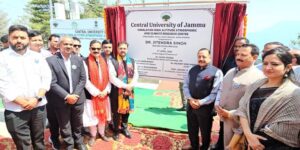NewzVille Desk
Minister of Science and Technology Dr. Jitendra Singh inaugurated the first-ever “Himalayan High Altitude Atmospheric and Climate Research Centre” in the higher hill reaches of Nathatop, Jammu and Kashmir. Addressing the gathering he said that today India opens a gateway into climate forecast and research in the Himalayas.
This is a move that marks a significant milestone in India’s global leadership in climate science, said the Minister, adding that Jammu & Kashmir spearheads India’s global initiative in climate study and research in the Himalayas.

The state-of-the-art facility, situated at one of the highest altitudes in the region, is expected to serve as a crucial gateway for cutting-edge climate research in the north-western Himalayas.
Coinciding with the inauguration, Dr. Jitendra Singh also flagged off the Indo-Swiss Joint Research Project “ICE-CRUNCH(Ice nucleating particles and cloud condensation nuclei properties in the North-Western Himalayas)” – a collaborative study between Indian scientists and researchers from ETH Zürich, Switzerland, aimed at exploring the properties of ice nucleating particles and cloud condensation nuclei in the region.
The minister underscored that the choice of Jammu and Kashmir for this facility was a conscious one, leveraging its high-altitude advantage for more accurate atmospheric and climate measurements. “The implication is that J&K also joins India’s global headways in addressing the climate concerns,” he said.
The Nathatop centre is a product of multi-tier collaboration—between the Government of India (through the Ministry of Science & Technology), the Government of Jammu and Kashmir (which provided the land), the Central University of Jammu (whose scientists will participate in research), and the Swiss National Science Foundation (which is providing international expertise).
“Preserving the Himalayas is not a regional concern but a global imperative,” Dr. Jitendra Singh said, emphasizing that the region’s vast unexplored resources could play a pivotal role in India’s future economic growth.
The Centre will serve as a long-term research hub affiliated with the World Meteorological Organization’s (WMO) Global Atmospheric Watch (GAW) Programme. In partnership with the Indian Meteorological Department, the aim is to conduct continuous atmospheric monitoring and eventually integrate data into global climate models.
Beyond scientific research, the Centre is expected to contribute to capacity building, training of young scientists, and development of climate modelling capabilities in India. It will also serve as a knowledge hub, offering training schools for students and professionals in atmospheric sciences.





